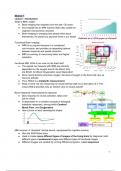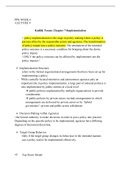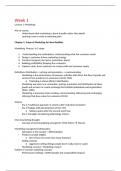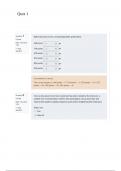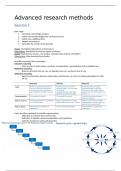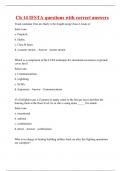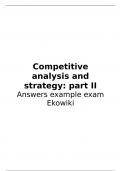1 of 11
Lecture 1
4-4-2022
Decision making with uncertainty about the result. How does this work?
2 options, do you switch or not? And with regards to being correct the first time or not.
At first, you have a 1/3 chance to get the right door. After your first choice, you get a 2/3
probability of getting the right door. It is thus better to switch since you then get a higher
probability.
What is quantitative decision making?
We provide students with the methods and tools to make better, more responsible, decisions in a
complex and dynamic world!
What makes a decision dif cult?
- A lot of options
- Contradicting objectives
- Uncertainty about the outcome
What makes a good decision?
- Criteria to evaluate the outcome
- Criteria to evaluate the process
—> Outcome bias: a bias in which people evaluate the quality of a decision solely based on the
outcome.
Management/leadership = making decisions
Newsvendor problem
Cost if you have too much, cost if you have too little (newspaper boy or airline company example)
Decision problem: structure
1. Possible decisions
2. Possible scenarios
3. Decision table = evaluation of possible decisions in different future scenarios
Example
Possible decisions:
- 1 flight (200(
- 2 flights (400)
Potential future scenarios:
demand= 100,200,300,400
Parameters:
$100 cost per seat
$200 ticket price
$80 penalty lost sales
Use this all to put in a decision table.
Quantitative decision making 2021-2022
fi
, 2 of 11
How many seats will we sell when we have a capacity of 200 and a demand of 300?
You cant sell more than your capacity and you cant sell more than the demand.
Thus, Sales= MIN(capacity, demand)
If demand> capacity, then out-of-stock = demand - capacity
But out-of-stock cannot be lower than 0!
Thus, MAX(Demand-capacity,0)
Sales - cost - out of stock (formula to use in decision table)
Three decision types
Type 1: under certainty (knows everything about outcomes)
Type 2: under uncertainty (knows nothing about outcomes)
Type 3: under risk (know probability distribution)
Decision criteria (under uncertainty)
1. Maximax (optimistic)
2. Maximin (pessimistic)
3. Realism criterium (Hurwicz)
4. Equal probability (Laplace)
5. Minimax regret
Watch out for the difference in for example sales/costs (is it a maximization problem or
minimization problem?)
- For each decision, determine the best outcome (max)
- Select the decision with the best outcome (max)
2. Maximin (worst-case)
A different decision in the end than maximax
3. Hurwicz criterion (weighted average between optimism and pessimism)
- select a coefficient A between 0 and 1
- 1 = 100% optimistic
- 0= 100% pessimistic
Which alfa do you select? The degree to which you are optimistic
4. Laplace criterion (equally likely)
Average of all possible outcomes
5. Minimax regret
Opportunity loss or regret = difference between the actual outcome and the best possible
outcome
The maximax criterion is a special case of the Hurwicz criterion (with alfa 1)
Quantitative decision making 2021-2022
Lecture 1
4-4-2022
Decision making with uncertainty about the result. How does this work?
2 options, do you switch or not? And with regards to being correct the first time or not.
At first, you have a 1/3 chance to get the right door. After your first choice, you get a 2/3
probability of getting the right door. It is thus better to switch since you then get a higher
probability.
What is quantitative decision making?
We provide students with the methods and tools to make better, more responsible, decisions in a
complex and dynamic world!
What makes a decision dif cult?
- A lot of options
- Contradicting objectives
- Uncertainty about the outcome
What makes a good decision?
- Criteria to evaluate the outcome
- Criteria to evaluate the process
—> Outcome bias: a bias in which people evaluate the quality of a decision solely based on the
outcome.
Management/leadership = making decisions
Newsvendor problem
Cost if you have too much, cost if you have too little (newspaper boy or airline company example)
Decision problem: structure
1. Possible decisions
2. Possible scenarios
3. Decision table = evaluation of possible decisions in different future scenarios
Example
Possible decisions:
- 1 flight (200(
- 2 flights (400)
Potential future scenarios:
demand= 100,200,300,400
Parameters:
$100 cost per seat
$200 ticket price
$80 penalty lost sales
Use this all to put in a decision table.
Quantitative decision making 2021-2022
fi
, 2 of 11
How many seats will we sell when we have a capacity of 200 and a demand of 300?
You cant sell more than your capacity and you cant sell more than the demand.
Thus, Sales= MIN(capacity, demand)
If demand> capacity, then out-of-stock = demand - capacity
But out-of-stock cannot be lower than 0!
Thus, MAX(Demand-capacity,0)
Sales - cost - out of stock (formula to use in decision table)
Three decision types
Type 1: under certainty (knows everything about outcomes)
Type 2: under uncertainty (knows nothing about outcomes)
Type 3: under risk (know probability distribution)
Decision criteria (under uncertainty)
1. Maximax (optimistic)
2. Maximin (pessimistic)
3. Realism criterium (Hurwicz)
4. Equal probability (Laplace)
5. Minimax regret
Watch out for the difference in for example sales/costs (is it a maximization problem or
minimization problem?)
- For each decision, determine the best outcome (max)
- Select the decision with the best outcome (max)
2. Maximin (worst-case)
A different decision in the end than maximax
3. Hurwicz criterion (weighted average between optimism and pessimism)
- select a coefficient A between 0 and 1
- 1 = 100% optimistic
- 0= 100% pessimistic
Which alfa do you select? The degree to which you are optimistic
4. Laplace criterion (equally likely)
Average of all possible outcomes
5. Minimax regret
Opportunity loss or regret = difference between the actual outcome and the best possible
outcome
The maximax criterion is a special case of the Hurwicz criterion (with alfa 1)
Quantitative decision making 2021-2022

